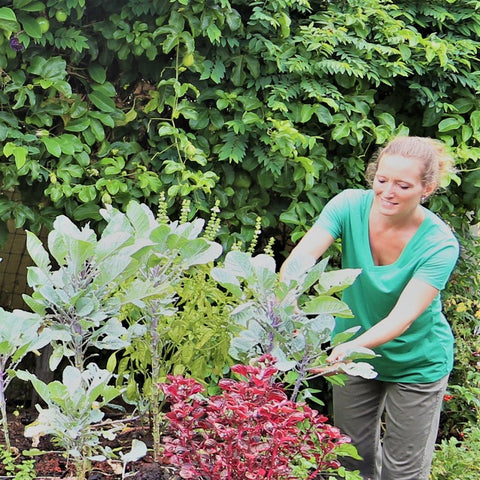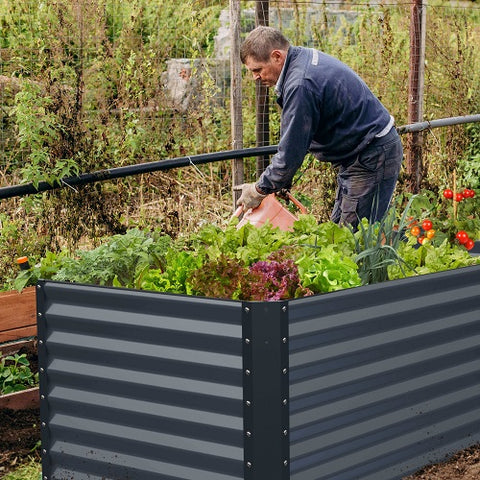Garlic is one of the most beneficial things you grow yourself. Garlic bulbs are delicious and can be preserved for a long time. As the growing season is coming, we are considering the opportunity. You may think: How long does it take for garlic to grow?The following content also has some reference value for raised garden beds.
Although it takes about 9 months for most varieties to grow from clove to mature, some short-season varieties need less time. The way garlic is grown will also affect when it can be harvested. Some garlic types allow you to easily breed and replant garlic from the garlic harvested last year, while others are more suitable for immediate use.
Planting garlic needs to decide whether you want to plant garlic in spring or autumn. Your USDA planting area is an important consideration. Problems in garlic planting will also change your time.
Therefore, let's examine all these factors to help you decide the type and planting time of garlic bulb, so that you can enjoy your own garlic in the next few years.
 In addition to harvesting garlic stems, you can also plant garlic at different stages of garlic growth. After harvesting garlic, the grower heals each garlic bulb in a good air circulation and uses a variety of methods to store garlic. During the growth process, gardeners can collect garlic seeds from flowers to grow again next year. They can also choose to plant garlic cloves. Each clove can be used as its own seed.
In addition to harvesting garlic stems, you can also plant garlic at different stages of garlic growth. After harvesting garlic, the grower heals each garlic bulb in a good air circulation and uses a variety of methods to store garlic. During the growth process, gardeners can collect garlic seeds from flowers to grow again next year. They can also choose to plant garlic cloves. Each clove can be used as its own seed.
Which type of plant you choose will affect your harvest time. Although clove cultivation takes about 9 months, garlic seeds take one year longer than garlic bulbs (sometimes called bulbs). This is because the seeds must germinate, grow the green plants needed for photosynthesis, and then go through the process of bulb formation. When you plant cloves, the first half of the process has been completed.
If you plan to plant garlic in the coming growing season, please consider the variety and its source! This will help you determine when to plant garlic. Some garlic varieties with cold climate like to eat when the temperature is low.
When to plant garlic
Another factor to consider when to harvest garlic is planting time. Although there are generally garlic planted in spring and garlic planted in autumn, there are also climate factors to consider. Soft-necked garlic is better planted in warm climate, while hard-necked garlic is best planted in cool climate. The difference between the two also exists in botany. We will discuss these issues in the following chapters.
Partition timing
Garlic is usually a part of autumn planting, 4 to 6 weeks before the first frost from early summer to early autumn. Because it can produce larger bulbs in cold winter, it is also most often planted in autumn. This general list is applicable to autumn planting. It is possible to plant garlic in spring, usually 4 to 6 weeks before the last frost in early spring. The soft neck varieties are suitable for the mild climate in Zone 6 and above, but some varieties are also suitable for cold weather, such as Poland's soft neck.
The time of planting cloves may depend on the season you plan, which largely depends on the planting area of the United States Department of Agriculture.
If you plant garlic associated plants next to garlic, please use their planting time to determine when to start planting garlic. For example, plant tomatoes next to garlic to prevent spider mites.
Whether you are interested in making garlic spray, or you want garlic to spread or produce garlic like the one you buy in the store, the type of garlic you grow will affect how you grow them. Soft neck and hard neck determine whether you plant in autumn or spring. Garlic planting in autumn should be carried out in winter and prepared in the middle of summer. Spring planting should be prepared in autumn. In a place where the growing season is long and cold enough, you may find that garlic can be harvested many times a year.
So let's discuss the types of garlic you can grow and how it can change your harvest time.
Garlic with stiff neck
 The reason why hard neck garlic is called hard neck garlic is that there is a stem in the center of its garlic, which will harden when mature. It has long flower stems, which will produce bulbs after flowering. It is usually cold resistant, because its skin is thick, so it is easier to peel. Each garlic bulb has only a few petals. If you plant and store hard-necked garlic, you will find that it does not last as long as garlic bought in stores. As we mentioned earlier, this kind of garlic grows best in cold weather.
The reason why hard neck garlic is called hard neck garlic is that there is a stem in the center of its garlic, which will harden when mature. It has long flower stems, which will produce bulbs after flowering. It is usually cold resistant, because its skin is thick, so it is easier to peel. Each garlic bulb has only a few petals. If you plant and store hard-necked garlic, you will find that it does not last as long as garlic bought in stores. As we mentioned earlier, this kind of garlic grows best in cold weather.
When it comes to the difficult harvest time, you will know that they are ready for 1/3 of the leaves to turn yellow. Because this variety is usually planted in autumn, you will harvest it from early summer to midsummer. Before that, you must remove the green leaves called garlic stems to ensure a decent harvest. This can promote the growth of lilac when the root system grows from the bulb.
Garlic with soft neck
The stems of soft-necked garlic are made of green garlic leaves instead of hard stems. Soft necks do not bloom - in any case, usually not - and therefore do not produce bulbs. Mature bulbs have more individual cloves than hard-necked bulbs, and they are much smaller. The garlic skin on the soft neck is paper and hard to peel. This kind of garlic grows best in warm climate and is usually planted in spring. Cloves with soft necks must be planted for breeding. This is the type you get when you buy garlic at the grocery store.
To determine the time of garlic belonging to the soft neck category, please know that they can be prepared at the earliest in early spring. When the top 5 to 6 leaves are still green, the bottom leaves have turned brown. Then remove them with a gardening fork.
Garlic green
If you are interested in planting garlic purely for green plants, you can harvest these garlic many times in a growing season. However, you must wait until late spring and early summer to do so. This is because bulbs need green plants to continue to form until harvest. If you don't want to harvest bulbs at the same time, remember to leave the leaves on the plant.
You may encounter problems of restricting garlic bulb growth and delaying harvest. This section will introduce these factors and how to limit them when planting.
Soil moisture
Because garlic needs a lot of water to grow, you need to keep the garden soil moist during the whole growth process. In most cases, poor harvest is due to dry soil. Especially when you grow in sunny conditions, it is very important to continuously monitor the water content in the soil. But you don't want to fall into the water. This will cause the bulbs to rot. This is the source of growth medium. An improved mixture of garden compost, rotting cow dung and sand will promote water, but also help drain water. Add 2 tablespoons of 5-10-10 fish meal to provide the required nutrition for the bulb. Even under direct sunlight, covering pine needles will help the soil retain moisture. Please keep this in mind when preparing the website.
Pest
At first, onion maggots will not cause much damage to the harvest, but after several generations, they will cause up to 50% of the yield loss. They first feed on garlic seedlings, and then on expanded bulbs in the second and third generations. Spraying pesticides in the planting area before planting will help eliminate the threat of onion maggots. Maggots and onion maggots are the same pests, but in the form of adults. The prevention methods to control them are cultural. Rotate garlic crops to prevent them. This can also prevent soil abrasion during the planting of delicious garlic bulbs.
The dry mite will also feed on garlic, thus reducing the yield and delaying the harvest. They belong to the same category as ticks and mites. They overwinter in stored cloves, and the affected plants are stunted. The female lays eggs on the hatched garlic leaves and releases hundreds of larvae, which gather on the bulbs to feed. Crop rotation will maintain the normal yield of garlic and prevent these mites. Hot water treatment of garlic seeds can also prevent them.
Consider these factors when gardening to ensure that you get timely and sufficient garlic harvest.









